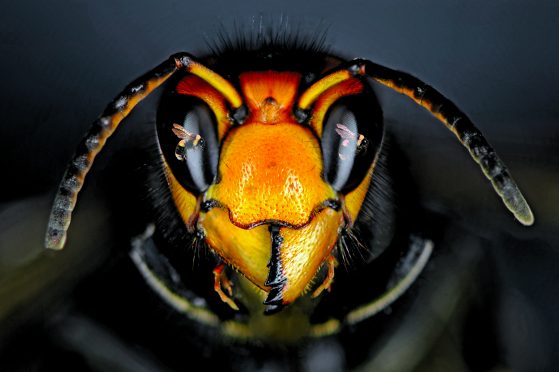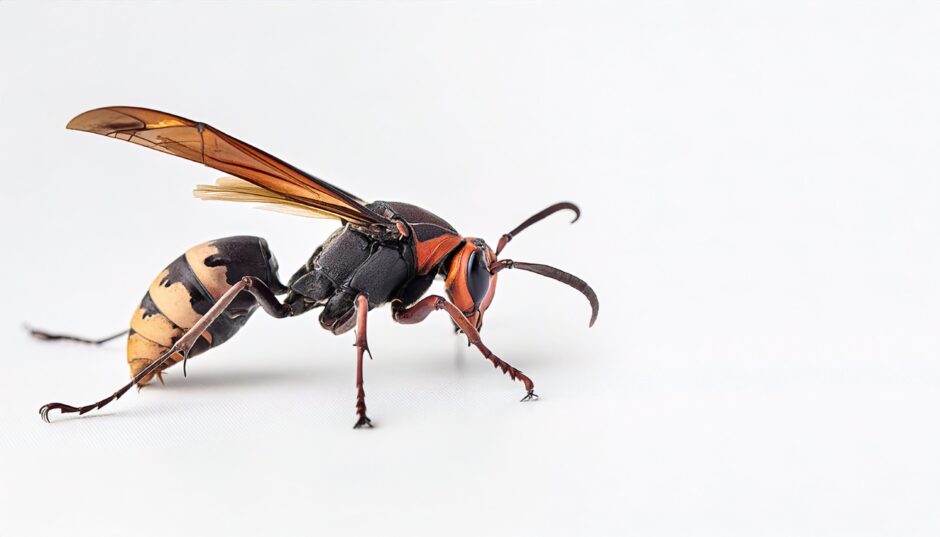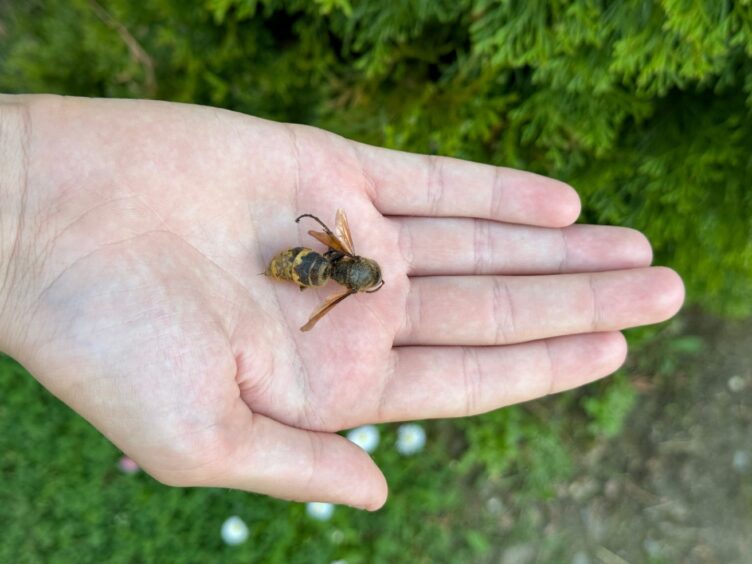
They have spread across Europe causing the gruesome death of millions of honey bees – and untold devastation to the countryside.
Now Asian hornets are heading for Scotland.
The Sunday Post can reveal that rapid response teams are being set up to track and destroy the aggressive and predatory insects as soon as they are spotted north of the border.
For although the creatures are only a couple of centimetres long, the threat they pose to the environment – and to bees in particular – is so severe the government has drawn up a 25-page contingency plan for dealing with them.
Asian hornets
A single hornet can kill up to 30 honey bees a day, pulling the heads off its victims and using the bodies to feed its young.
And with 6,000 hornets sharing a nest, the deadly toll on one of the nation’s best-loved insects is multiplied – potentially causing the death of 180,000 bees per day.
In a move that could cost farmers millions of pounds in lost revenue, the hornets also target other species of pollinating insects which are vital to many types of agriculture.
Wildlife agency NatureScot is now so concerned about the imminent arrival in Scotland of the Asian hornet – also known as yellow-legged hornet – it is currently advertising for rapid response pest disposal teams.
As soon as a sighting is confirmed, the teams will be called upon to urgently find, remove and destroy the nests, as well as making sure that every hornet is killed and no stragglers remain.
Meanwhile, the public are also being asked to report any suspected sightings – although people are warned not to approach the hornets as they can become defensive and deliver a painful sting.
Stan Whitaker, NatureScot’s expert on invasive, non-native species, said: “Yellow-legged hornets are a serious threat to honeybees and other native bees if they arrive in Scotland. They have no native predators, and they have spread quickly in France.
“As they can cause significant harm to pollinators, there is a comprehensive contingency plan in place to deal with any sightings. This includes swift action to locate and destroy any hornet nests.
“But we can only do this if people report any possible sightings, so we urge beekeepers and others who think they may have seen a yellow-legged hornet to report it immediately.”
Hornets spread
Known in Latin as vespa velutina nigrithorax, the yellow-legged hornet is one of many species of hornet found in Asia. In around 2004 the hornets first arrived in France, thought to have been accidentally imported from China.
With no native predators in Europe to control their numbers, the creatures then rapidly spread to Spain, Portugal, Italy, Germany and the Netherlands.
In 2016 the first Asian hornets were confirmed in southern England, having either flown across the English Channel or been carried in aboard ferries or container ships.
Since then, sightings have increased as the insects have spread northwards.
By the beginning of December, the UK’s National Bee Unit had reported 71 credible sightings and 24 nests across England in 2024 – as far north as Preston in Lancashire, just 100 miles from Scotland.
So far there has been only one credible Scottish sighting, at a supermarket distribution centre in the central belt in 2017 – although this was never formally confirmed.
However, experts believe it is now only a matter of time – with the Asian hornet officially considered to have a “high risk of arriving, establishing and impacting biodiversity and ecosystems in Scotland”.
Although Asian hornets are similar in size and shape to native insects such as the giant woodwasp and the giant horsefly, they can be distinguished by their yellow legs and very dark body, which has two yellow stripes on the abdomen.
The number of individuals in a nest increases over the summer and peaks by September, when there can be thousands of hungry larvae requiring meat to complete their development.
Adults can be spotted hovering around compost heaps, fallen fruit and beehives, or picking off pollinators as they feed on late ivy flowers.
The British Beekeepers Association (BBKA) has warned: “These are voracious predators which poses a significant threat to honey bees and all native insects – as they have no natural predators in the UK.
“Yellow-legged Asian hornets can wreak havoc on our wildlife through their destruction of honey bee colonies and their predation on a number of other insect species.
“Their habit of hovering outside beehives stops the bees from going out to collect nectar and pollen to feed themselves.
“Just one nest of hornets can consume up to around 11kg of insects in a year. This could have huge consequences on our wider ecology, with many beekeepers calling this the greatest threat to our native pollinators in a generation.”
Earlier this year a 25-page Yellow-legged Asian Hornet Contingency Plan was published, describing how the Scottish Government, NatureScot and other wildlife organisations should respond if the creatures are discovered in Scotland.
The plan outlines “the processes and governance for search, identification, confirmation, co-ordination and response, and post-incident management”.
It states: “Any incursion of the Asian hornet in Scotland requires immediate action to prevent establishment and significant harm to our population of bees and other pollinators.”
The report outlines measures to detect the presence of the hornets as quickly as possible, then “intercept and eradicate”.
It adds that “where eradication and control are no longer possible due to the number and extent of incursions” then long-term management will be required, including “pest and disease control”.
Anyone spotting an Asian hornet is asked to use their smartphone to report the sighting, using the Asian Hornet Watch App.

Enjoy the convenience of having The Sunday Post delivered as a digital ePaper straight to your smartphone, tablet or computer.
Subscribe for only £5.49 a month and enjoy all the benefits of the printed paper as a digital replica.
Subscribe © Shutterstock / Chase D'animulls
© Shutterstock / Chase D'animulls © Shutterstock / MaXX12
© Shutterstock / MaXX12